The Machine Learning Pipeline on AWS
The Machine Learning Pipeline on AWS
current course dates can be found at the bottom of this page … company training available on request!
Course description
Learn how to use the machine learning (ML) pipeline with Amazon SageMaker with hands-on exercises and four days of instruction. You will learn how to frame your business problems as ML problems and use Amazon SageMaker to train, evaluate, tune, and deploy ML models. Hands-on learning is a key component of this course, so you’ll choose a project to work on, and then apply the knowledge and skills you learn to your chosen project in each phase of the pipeline. You’ll have a choice of projects: fraud detection, recommendation engines, or flight delays.
Course objectives
In this course, you will learn to:
- Select and justify the appropriate ML approach for a given business problem
- Use the ML pipeline to solve a specific business problem
- Train, evaluate, deploy, and tune an ML model in Amazon SageMaker
- Describe some of the best practices for designing scalable, cost-optimized, and secure ML pipelines in AWS
- Apply machine learning to a real-life business problem after the course is complete
Intended audience
This course is intended for:
- Developers
- Solutions architects
- Data engineers
- Anyone who wants to learn about the ML pipeline via Amazon SageMaker, even if you have little to no experience with machine learning
Prerequisites
We recommend that attendees of this course have:
- Basic knowledge of Python
- Basic understanding of AWS Cloud infrastructure (Amazon S3 and Amazon CloudWatch)
- Basic understanding of working in a Jupyter notebook environment
Activities
This course includes:
- Training with instructor
- Practical exercises
- Group exercices
Course duration / Price
- 4 days
- € 2,795.00 (excl. tax) per person (DE)
- CHF 3,700.00 (excl. tax) per person (CH)
Course outline
Day 1:
Module 0: Introduction
• Pre-assessment
Module 1: Introduction to Machine Learning and the ML Pipeline
• Overview of machine learning, including use cases, types of machine learning, and key concepts
• Overview of the ML pipeline
• Introduction to course projects and approach
Module 2: Introduction to Amazon SageMaker
• Introduction to Amazon SageMaker
• Demo: Amazon SageMaker and Jupyter notebooks
• Hands-on: Amazon SageMaker and Jupyter notebooks
Module 3: Problem Formulation
• Overview of problem formulation and deciding if ML is the right solution
• Converting a business problem into an ML problem
• Demo: Amazon SageMaker Ground Truth
• Hands-on: Amazon SageMaker Ground Truth
Day 2:
Module 3: Problem Formulation (continued)
• Practice problem formulation
• Formulate problems for projects
Checkpoint 1 and Answer Review
Module 4: Preprocessing
• Overview of data collection and integration, and techniques for data preprocessing and visualization
• Practice preprocessing
• Preprocess project data and discuss project progress
Day 3:
Checkpoint 2 and Answer Review
Module 5: Model Training
• Choosing the right algorithm
• Formatting and splitting your data for training
• Loss functions and gradient descent for improving your model
• Demo: Create a training job in Amazon SageMaker
Module 6: Model Evaluation
• How to evaluate classification models
• How to evaluate regression models
• Practice model training and evaluation
• Train and evaluate project models, then present findings
Day 4:
Checkpoint 3 and Answer Review
Module 7: Feature Engineering and Model Tuning
• Feature extraction, selection, creation, and transformation
• Hyperparameter tuning
• Demo: SageMaker hyperparameter optimization
• Practice feature engineering and model tuning
• Apply feature engineering and model tuning to projects
• Final project presentations
Module 8: Deployment
• How to deploy, inference, and monitor your model on Amazon SageMaker
• Deploying ML at the edge
• Demo: Creating an Amazon SageMaker endpoint
• Post-assessment
• Course wrap-up
IMPORTANT: Please bring your notebook (Windows, Linux or Mac) to our trainings. If this is not possible, please contact us in advance.
Course materials are in English, on request also in German (if available).
Course language is German, on request also in English.



 objectives
objectives